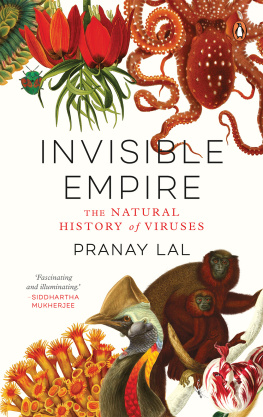A Planet of VIRUSES
Carl Zimmer
The University of Chicago Press
Chicago and London
CARL ZIMMER writes about science for the New York Times and other publications and is the author of eight books, including Parasite Rex , Soul Made Flesh , and Microcosm . He is a lecturer at Yale University, where he teaches writing about science and the environment, and visiting scholar at the Science, Health, and Environment Reporting Program at New York Universitys Arthur L. Carter Journalism Institute.
The University of Chicago Press, Chicago 60637
The University of Chicago Press, Ltd., London
2011 by The Board of Regents of the University of Nebraska
All rights reserved. Published 2011.
Printed in the United States of America
20 19 18 17 16 15 14 13 12 11 1 2 3 4 5
ISBN-13: 978-0-226-98335-6 (cloth)
ISBN-10: 0-226-98335-8 (cloth)
The essays in this book were written for the World of Viruses project, funded by the National Center for Research Resources at the National Institutes of Health through the Science Education Partnership Award (SEPA) Grant No. R25 RR024267 (20072012). Its content is solely the responsibility of the authors and does not necessarily represent the official views of NCRR or NIH. Visit http://www.worldofviruses.unl.edu for more information and free educational materials about viruses. World of Viruses is a project of the University of NebraskaLincoln.
Library of Congress Cataloging-in-Publication Data
Zimmer, Carl, 1966
A planet of viruses / Carl Zimmer.
p. cm.
Includes bibliographical references and index.
ISBN-13: 978-0-226-98335-6 (cloth : alk. paper)
ISBN-10: 0-226-98335-8 (cloth : alk. paper) 1. Viruses. I. Title.
QR360.Z65 2011
362.1969dc22
2010036742
 This paper meets the requirements of ANSI/NISO Z39.48-1992 (Permanence of Paper).
This paper meets the requirements of ANSI/NISO Z39.48-1992 (Permanence of Paper).
ISBN 978-0-226-98333-2 (electronic)
To Grace, my favorite host
Contents
INTRODUCTION
A Contagious Living Fluid: Tobacco Mosaic Virus
The Uncommon Cold
Rhinovirus
Looking Down from the Stars
Influenza Virus
Rabbits with Horns
Human Papillomavirus
The Enemy of Our Enemy
Bacteriophages
The Infected Ocean
Marine Phages
Our Inner Parasites
Endogenous Retroviruses
The Young Scourge
Human Immunodeficiency Virus
Becoming an American
West Nile Virus
Predicting the Next Plague
Severe Acute Respiratory Syndrome and Ebola
The Long Goodbye
Smallpox
EPILOGUE
The Alien in the Watercooler: Mimivirus
Foreword
Viruses wreak chaos on human welfare, affecting the lives of almost a billion people. They have also played major roles in the remarkable biological advances of the past century. The smallpox virus was humanitys greatest killer, and yet it is now one of the only diseases to have been eradicated from the globe. New viruses, such as HIV, continue to pose new threats and challenges.
Viruses are unseen but dynamic players in the ecology of Earth. They move DNA between species, provide new genetic material for evolution, and regulate vast populations of organisms. Every species, from tiny microbes to large mammals, is influenced by the actions of viruses. Viruses extend their impact beyond species to affect climate, soil, the oceans, and fresh water. When you consider how every animal, plant, and microbe has been shaped through the course of evolution, one has to consider the influential role played by the tiny and powerful viruses that share this planet.
Carl Zimmer wrote these essays for the World of Viruses project as part of a Science Education Partnership Award (SEPA) from the National Center for Research Resources (NCRR) at the National Institutes of Health (NIH). World of Viruses was created to help people understand more about viruses and virology research through radio documentaries, graphic stories, teacher professional development, mobile phone and iPad applications, and other materials. For more information about World of Viruses, visit http://www.worldofviruses.unl.edu .
JUDY DIAMOND, PhD
Professor and Curator, University of Nebraska State Museum
Director of the World of Viruses Project
CHARLES WOOD, PhD
Lewis L. Lehr University Professor of Biological Sciences and Biochemistry
Director of the Nebraska Center for Virology

Introduction
A Contagious Living Fluid
Tobacco Mosaic Virus
Fifty miles southeast of the Mexican city of Chihuahua is a dry, bare mountain range called Sierra de Naica. In 2000, miners worked their way down through a network of caves below the mountains. When they got a thousand feet underground, they found themselves in a place that seemed to belong to another world. They were standing in a chamber measuring thirty feet wide and ninety feet long. The ceiling, walls, and floor were lined with smooth-faced, translucent crystals of gypsum. Many caves contain crystals, but not like the ones in Sierra de Naica. They measured up to thirty-six feet long apiece and weighed as much as fifty-five tons. These were not crystals to hang from a necklace. These were crystals to climb like hills.
Since its discovery, a few scientists have been granted permission to visit this extraordinary chamber, known now as the Cave of Crystals. Juan Manuel Garca-Ruiz, a geologist at the University of Granada, made the journey and figured out that the crystals formed when volcanoes began to form the mountains 26 million years ago. Subterranean chambers took shape and filled with hot mineral-laced water. The heat of the volcanic magma kept the water at around 136 degrees, the ideal temperature for the minerals to settle out of the water and form crystals. Somehow the water stayed at that perfect temperature for hundreds of thousands of years, allowing the crystals to grow to surreal sizes.
In 2009, another scientist, Curtis Suttle, paid a visit to the Cave of Crystals. Suttle and his colleagues scooped up water from the chambers pools and brought it back to their laboratory at the University of British Columbia to analyze. When you consider Suttles line of work, his journey might seem like a fools errand. Suttle has no professional interest in crystals, or minerals, or any rocks at all for that matter. He studies viruses.
There are no people in the Cave of Crystals for the viruses to infect. There are not even any fish. The cave has been effectively cut off from the biology of the outside world for millions of years. Yet Suttles trip was well worth the effort. After he prepared his samples of crystal water, he put them under a microscope and saw protein shells loaded with genes. Each drop of cave water may hold two hundred million viruses.
Just about wherever scientists lookdeep within the earth, on grains of sand blown off of the Sahara Desert, under mile-thick layers of Antarctic icethey find viruses. And when they look in familiar places, they find new ones. In 2009, Dana Willner, a biologist at San Diego State University, led a virus-hunting expedition into the human body. The scientists had ten people cough up sputum and spit it into a cup. Five of the people were sick with cystic fibrosis, and five were healthy. Out of that fluid, Willner and her team fished out fragments of DNA, which they compared to databases of the tens of millions of genes already known to science. Before Willners study, the lungs of healthy people were believed to be sterile. But Willner and her colleagues discovered that all their subjects, sick and healthy alike, carried viral menageries in their chests. On average, each person had 174 species of viruses in the lungs. But only 10 percent of those species bore any close kinship to any virus ever found before. The other 90 percent were as strange as anything lurking in the Cave of Crystals.
Next page
















 This paper meets the requirements of ANSI/NISO Z39.48-1992 (Permanence of Paper).
This paper meets the requirements of ANSI/NISO Z39.48-1992 (Permanence of Paper).